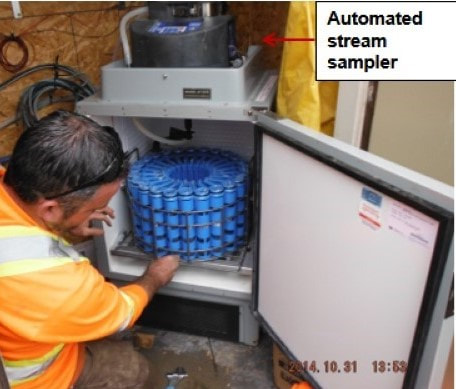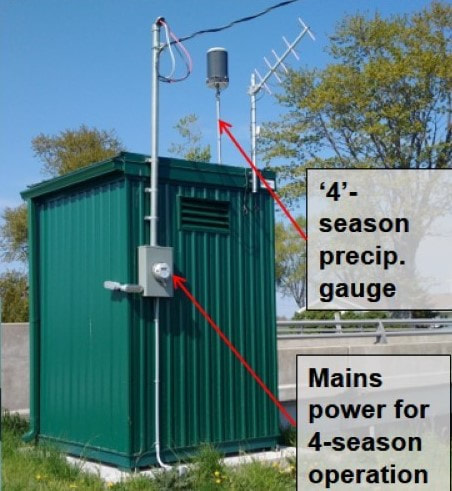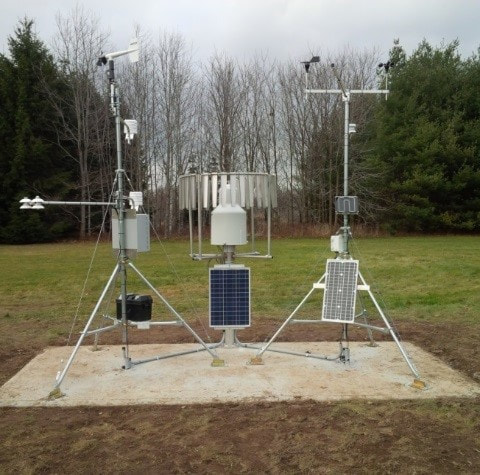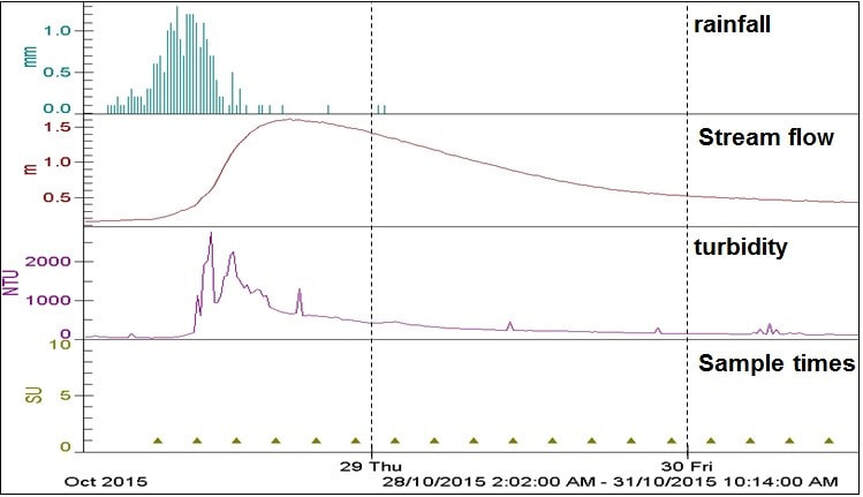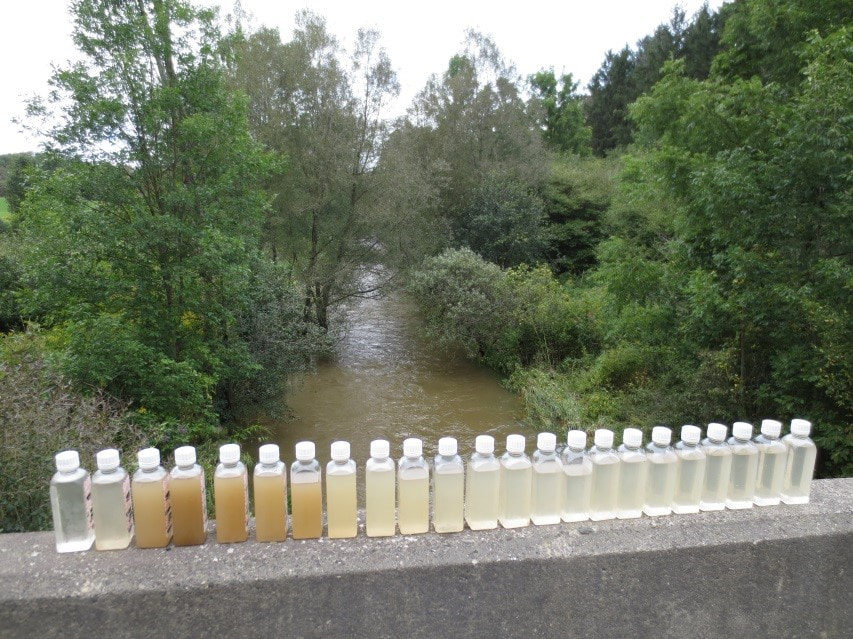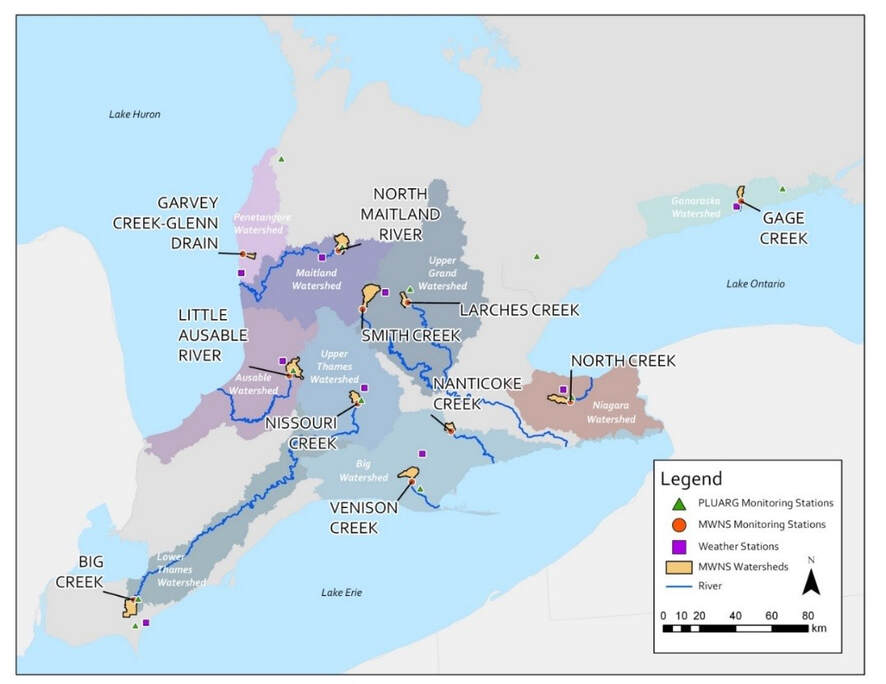
Ontario Ministry of the Environment, Conservation, and Parks (MECP): Multi-Watershed Nutrient Study
Beginning in 2014, the Ministry of the Environment, Conservation and Parks (MECP) has initiated the Multi-Watershed Nutrient Study (MWNS), in partnership with the Universities of Windsor, Waterloo, and Ryerson, as well as federal and provincial agencies and Conservation Authorities. The goals of the Study are to examine the relationships among agricultural land use, land management, and nutrient loading in streams that flow to the Great Lakes. The MWNS work will also examine how changes in land use, land management, and climate can affect water quality and nutrient loading over time.
In the 1970s, the International Joint Commission (IJC) led the Pollution from Land Use Activities Reference Group (PLUARG), in response to intensive nutrient-related issues in the Great Lakes, including large harmful algal blooms and fish die-offs. Following PLAURG, changes in policies and practices resulted in vast improvements to water quality in the Great Lakes. However, in the intervening period, there has been a resurgence in nutrient-related issues in the Great Lakes. Why this is occurring and understanding how to manage these issues has become important once again.
With the efforts of partners, the MWNS studies many of the same PLUARG watersheds 40 years later in present day. With the information gathered, the MWNS will help shed light on differences between what was happening then and what might have changed over time, and ask questions such as:
A total of 11 sub-watersheds were selected (Rosamond et al., 2018: 10.1016/j.scitotenv.2018.03.113) and actively monitored for the MWNS, six of which were monitored during PLUARG (see map). The MWNS sites are typical of Southern Ontario and are considered “Sentinel Watersheds”. Sentinel Watersheds experience water runoff and nutrient balances that are representative of the types of watersheds found in the province and can help describe and predict the connection between land use, land management, climate, and nutrient loading. By understanding how these factors interact in Sentinel Watersheds, better predictions can be made for other watersheds in the province of Ontario.
Watersheds monitored under the MWNS, southern Ontario, Canada.
Each study watershed includes a water monitoring station and a nearby weather station. Each water monitoring station includes a hut containing automated sampling equipment that is remotely triggered to collect water samples during a range of stream flow conditions, including baseline or low flow and high flow (following rainfall and snow melt). Water samples are then collected by partners and sent off to laboratories for analysis of nutrients and other analytes. In-stream sensors are also deployed at each site to collect real-time data for water level, turbidity, and temperature.
Beginning in 2014, the Ministry of the Environment, Conservation and Parks (MECP) has initiated the Multi-Watershed Nutrient Study (MWNS), in partnership with the Universities of Windsor, Waterloo, and Ryerson, as well as federal and provincial agencies and Conservation Authorities. The goals of the Study are to examine the relationships among agricultural land use, land management, and nutrient loading in streams that flow to the Great Lakes. The MWNS work will also examine how changes in land use, land management, and climate can affect water quality and nutrient loading over time.
In the 1970s, the International Joint Commission (IJC) led the Pollution from Land Use Activities Reference Group (PLUARG), in response to intensive nutrient-related issues in the Great Lakes, including large harmful algal blooms and fish die-offs. Following PLAURG, changes in policies and practices resulted in vast improvements to water quality in the Great Lakes. However, in the intervening period, there has been a resurgence in nutrient-related issues in the Great Lakes. Why this is occurring and understanding how to manage these issues has become important once again.
With the efforts of partners, the MWNS studies many of the same PLUARG watersheds 40 years later in present day. With the information gathered, the MWNS will help shed light on differences between what was happening then and what might have changed over time, and ask questions such as:
- Are nutrient loadings to streams from agricultural land different now compared to 40 years ago?
- Has the relationship between agricultural land use and nutrient loadings changed over this time?
- Has the seasonal pattern of nutrient loading changed over time?
- Have the relevant forms of phosphorus loading (total vs. dissolved) changed over time?
A total of 11 sub-watersheds were selected (Rosamond et al., 2018: 10.1016/j.scitotenv.2018.03.113) and actively monitored for the MWNS, six of which were monitored during PLUARG (see map). The MWNS sites are typical of Southern Ontario and are considered “Sentinel Watersheds”. Sentinel Watersheds experience water runoff and nutrient balances that are representative of the types of watersheds found in the province and can help describe and predict the connection between land use, land management, climate, and nutrient loading. By understanding how these factors interact in Sentinel Watersheds, better predictions can be made for other watersheds in the province of Ontario.
Watersheds monitored under the MWNS, southern Ontario, Canada.
Each study watershed includes a water monitoring station and a nearby weather station. Each water monitoring station includes a hut containing automated sampling equipment that is remotely triggered to collect water samples during a range of stream flow conditions, including baseline or low flow and high flow (following rainfall and snow melt). Water samples are then collected by partners and sent off to laboratories for analysis of nutrients and other analytes. In-stream sensors are also deployed at each site to collect real-time data for water level, turbidity, and temperature.
Example of an MWNS sampling hut, automatic sampling equipment, and nearby weather station.
Example of how stream water level and turbidity respond to an intensive rain event and when Study water samples are collected by automated sampling equipment.
Samples collected over a rainfall event, showing the change in stream turbidity over the duration of the storm (first sample bottle shown on the far left).
The information collected during the MWNS will help to understand the magnitude of nutrients delivered to agricultural watersheds but will also contribute to understanding how and when the different forms of nutrients (e.g., dissolved and non-dissolved phosphorus) are delivered to, and transformed, within a stream. These different forms can influence the eutrophication potential (or ‘bioavailability’) of nutrients delivered to the Great Lakes. Partners at the University of Waterloo are actively involved on this portion of the MWNS.
In addition to stream water data collection, modelling approaches are applied in this work. In 2016, Dr. Wellen’s group began developing a modelling framework to understand nutrient export in MWNS watersheds, as well as a regional-scale analysis that will extend to larger geographical areas that are affecting the lower Great Lakes. Detailed farmer surveys (through AgriModel: https://www.agri-model.com/, under the direction of Dr. Wellen) are also being conducted in each MWNS watershed to better understand the current practices and activities occurring on the landscape.
Through the combined efforts of project partners like Dr. Wellen’s group, the MWNS strives to better understand the mechanisms by which nutrients are lost from landscapes, the timing and magnitude of these losses, and how within-river processes affect their delivery to, and their potential effects on, the Great Lakes. Comparing ‘Then and Now’ (PLUARG vs MWNS) allows for a better understanding of critical factors, such as changes in land-use activities and climate factors that may contribute to the recent resurgence of eutrophication in the Great Lakes.
News Coverage:
Ontario Farmer. Summer 2017. How do we know we are doing better than 40 years ago? By Karen Dallimaore
xxx
Scientific publications:
Rosamond, M.S., C. Wellen, M.A. Yousif, G. Kaltenecker, J.L. Thomas, P.J. Joosse, N.C. Feisthauer, W.D. Taylor, M.N. Mohamed (2018) Representing a large region with few sites: The Quality Index approach for field studies. Science of the Total Environment. 633:600-607. 10.1016/j.scitotenv.2018.03.113
Pardy, Alexander (2019). Then and Now: Understanding Change on an Agricultural Landscape. Masters Thesis. Ryerson University, Department of Geography and Environmental Studies.
A 2-page synopsis of the Multi-Watershed Nutrient Study and partner projects is available here.
List of presentations given throughout the partnership:
Pardy, A., C. Wellen, J. Thomas, M. Mohamed, M. Yousif, R. Sorichetti (2019) Then and Now: An Analysis of Agricultural Landscape Changes. Presented at International Union of Geodesy and Geophysics (IUGG) Conference. Montreal. July 11, 2019
Pardy, A., C. Wellen, J. Thomas, M. Mohamed, R. Sorichetti (2019) Understanding Change to the Phosphorus Balance on an Agricultural Landscape Over Multi-Decadal Timescales. Presented at Canadian Geophysical Union Eastern Student Conference. Toronto, ON. April 13, 2019
Mandal, S., C. Wellen, M. Mohamed, R. Sorichetti. (2019) Regional Watershed Modelling using HYPE (2019) Presented at Canadian Geophysical Union Eastern Student Conference. Toronto, ON. April 13, 2019
Wellen, C., J. Lee, S Rasiah, A. Pardy, S. Mandal (2019) Decadal Land Use Changes and the Effect of Headwater Agricultural Phosphorus Losses in the Lower Laurentian Great Lakes Basin. Presented at Canadian Water Resources Association Conference. Blue Mountain, ON. May 28, 2019
Sorichetti, R (2018) The Multi-Watershed Nutrient Study: Assessing the Scope for Change in Agricultural Nutrient Loading. Presented at Latornell Conservation Symposium. Alliston, ON. November 13, 2018
Parsons, C. (2018) Phosphorus Export from Headwater Streams in the Thames and Ausable River Watersheds; Storms, Snow-melt and Speciation. Presented at Latornell Conservation Symposium. Alliston, ON. November 13, 2018
Wellen, C., J. Lee, S Rasiah, A. Pardy, M. Mohamed, J. Thomas (2018) Modeling Phosphorus Loading in Agricultural Watersheds Across Southern Ontario. Presented at 61st International Association of Great Lakes Research (IAGLR) Conference. Toronto, ON. June 21, 2018
Thomas, J., R. Sorichetti, C. Wellen, C. Parsons, G. Ferguson, C. Vieira, M. Mohamed (2018) Enhanced Partnership Development to Expand and Achieve Common Study Goals. Presented at 61st International Association of Great Lakes Research (IAGLR) Conference. Toronto, ON. June 21, 2018
Smith, D., G. Arabian, L. Benakoun (2018) Logistical Considerations for the Development and Operation of an Automated Monitoring Network. Presented at 61st International Association of Great Lakes Research (IAGLR) Conference. Toronto, ON. June 21, 2018
Luymes, M., C. Wellen, J. Thomas, M. Mohamed (2018) Engaging Farmers in Watershed Research: Lessons Learned and Future Perspectives. Presented at 61st International Association of Great Lakes Research (IAGLR) Conference. Toronto, ON. June 21, 2018
Arabian, G., L. Benakoun, D. Smith. (2018) Collecting, Maintaining and Sharing Large Environmental Datasets. Presented at 61st International Association of Great Lakes Research (IAGLR) Conference. Toronto, ON. June 21, 2018
Yousif, M., M. Mohamed, C. Parsons, R. Sorichetti, J. Thomas, C. Wellen (2018) Nutrient Export from Agricultural Watersheds in Ontario Then and Now - A Comparison Across 40 Years. Presented at 61st International Association of Great Lakes Research (IAGLR) Conference. Toronto, ON. June 21, 2018
Parsons, C., P. Van Cappellen, M. Mohamed (2018) Phosphorus Export from Headwater Streams in the Lake Erie Basin: Storms, Snow-Melt and Speciation. Presented at 61st International Association of Great Lakes Research (IAGLR) Conference. Toronto, ON. June 21, 2018
Rosamond, M.S., C. Wellen, M.A. Yousif, G. Kaltenecker, JL Thomas, PJ Joosse, NC Feisthauer, WD Taylor, MN Mohamed (2018) Representing a Large Region with Few Sites: The Quality Index Approach for Field Studies. Presented at 61st International Association of Great Lakes Research (IAGLR) Conference. Toronto, ON. June 21, 2018
Parsons, C. (2018) Phosphorus Speciation, Bioavailability and Loadings from the Thames River to Lake St. Clair. Presented at the Focus of the Thames Forum. London, ON. March 28, 2018
Wellen, C., C. Parsons, J. Thomas, M. Mohamed (2017) Making the Connection: Understanding Sources and Transformations of Nutrients in Agricultural Landscapes from Headwaters to the Great lakes. Presented at Lake Erie Millennium Network (LEMN) Meeting. Windsor, ON. Feb 21, 2017
Wellen, C., M.N. Mohamed (2017) Advancing Policy-Science Dialog Using Models: An Example of Watershed Modeling in Ontario. Presented at 60th International Association of Great Lakes Research (IAGLR) Conference. Detroit, MI. May 15, 2017
Parsons, C., M.N. Mohamed (2017) Eutrophication in the Laurentian Great Lakes Basin: Past, Present and Future. Presented at 60th International Association of Great Lakes Research (IAGLR) Conference. Detroit, MI. May 15, 2017.
Wellen, C., P. Van Cappellen, M. N. Mohamed (2016) How Much Data is Needed to Empirically Detect Changes in Water Quality in Agricultural Watersheds? Presented at Canadian Meteorological and Oceanographic Society (CMOS) and Canadian Geophysical Union (CGU) Joint Scientific Congress. Fredericton, NB. June 2016
Rosamond, M.S., M.N. Mohamed, W.D. Taylor (2016) Has Total Phosphorus Export from Small, Agricultural Streams in Ontario Increased Since the 1970s? Presented at International Association of Great Lakes Research (IAGLR). Guelph, ON, June 6-10, 2016
Rosamond, M., Z. Hu, M. Mohamed, W.D. Taylor (2016) Relating Particulate and Dissolved Phosphorus Fractions to Season and Land Use in Agricultural Streams. Presented at 67th Canadian Conference of Fisheries Research/Society of Canadian Limnologists. St. Johns, NL. January 7-9, 2016
Mohamed, M., G. Kaltenecker, W.D. Taylor, M. Rosamond, K.M. Chomicki (2015) The re-Eutrophication of the Laurentian Great Lakes: Potential Influence of Changes in Agricultural Land Use, Climate, and Transport Pathways. Presented at Joint Assembly of the American Geophysical Union (AGU), Canadian Geophysical Union (CGU), Geological Association of Canada (GAC), and Mineralogical Association of Canada (MAC). Montreal, QB. May 3-7, 2015
Rosamond, M., M. Mohamed, W.D. Taylor (2015) Sediment P in Agricultural Streams: Response to Land Use and Influence on Total Phosphorus Export. Presented at European Geophysical Union (EGU) General Assembly. Vienna, Austria, April 12-17, 2014
Mohamed, M., K.M. Chomicki, & T.L. Long (2014) Winter, Spring, Summer, Fall- Why Does Season Matter to Loadings at All? A Synthesis of the Current Issue. Presented at 57th International Association of Great Lakes Research (IAGLR) Conference. Hamilton, ON. May 26-30, 2014
The information collected during the MWNS will help to understand the magnitude of nutrients delivered to agricultural watersheds but will also contribute to understanding how and when the different forms of nutrients (e.g., dissolved and non-dissolved phosphorus) are delivered to, and transformed, within a stream. These different forms can influence the eutrophication potential (or ‘bioavailability’) of nutrients delivered to the Great Lakes. Partners at the University of Waterloo are actively involved on this portion of the MWNS.
In addition to stream water data collection, modelling approaches are applied in this work. In 2016, Dr. Wellen’s group began developing a modelling framework to understand nutrient export in MWNS watersheds, as well as a regional-scale analysis that will extend to larger geographical areas that are affecting the lower Great Lakes. Detailed farmer surveys (through AgriModel: https://www.agri-model.com/, under the direction of Dr. Wellen) are also being conducted in each MWNS watershed to better understand the current practices and activities occurring on the landscape.
Through the combined efforts of project partners like Dr. Wellen’s group, the MWNS strives to better understand the mechanisms by which nutrients are lost from landscapes, the timing and magnitude of these losses, and how within-river processes affect their delivery to, and their potential effects on, the Great Lakes. Comparing ‘Then and Now’ (PLUARG vs MWNS) allows for a better understanding of critical factors, such as changes in land-use activities and climate factors that may contribute to the recent resurgence of eutrophication in the Great Lakes.
News Coverage:
Ontario Farmer. Summer 2017. How do we know we are doing better than 40 years ago? By Karen Dallimaore
xxx
Scientific publications:
Rosamond, M.S., C. Wellen, M.A. Yousif, G. Kaltenecker, J.L. Thomas, P.J. Joosse, N.C. Feisthauer, W.D. Taylor, M.N. Mohamed (2018) Representing a large region with few sites: The Quality Index approach for field studies. Science of the Total Environment. 633:600-607. 10.1016/j.scitotenv.2018.03.113
Pardy, Alexander (2019). Then and Now: Understanding Change on an Agricultural Landscape. Masters Thesis. Ryerson University, Department of Geography and Environmental Studies.
A 2-page synopsis of the Multi-Watershed Nutrient Study and partner projects is available here.
List of presentations given throughout the partnership:
Pardy, A., C. Wellen, J. Thomas, M. Mohamed, M. Yousif, R. Sorichetti (2019) Then and Now: An Analysis of Agricultural Landscape Changes. Presented at International Union of Geodesy and Geophysics (IUGG) Conference. Montreal. July 11, 2019
Pardy, A., C. Wellen, J. Thomas, M. Mohamed, R. Sorichetti (2019) Understanding Change to the Phosphorus Balance on an Agricultural Landscape Over Multi-Decadal Timescales. Presented at Canadian Geophysical Union Eastern Student Conference. Toronto, ON. April 13, 2019
Mandal, S., C. Wellen, M. Mohamed, R. Sorichetti. (2019) Regional Watershed Modelling using HYPE (2019) Presented at Canadian Geophysical Union Eastern Student Conference. Toronto, ON. April 13, 2019
Wellen, C., J. Lee, S Rasiah, A. Pardy, S. Mandal (2019) Decadal Land Use Changes and the Effect of Headwater Agricultural Phosphorus Losses in the Lower Laurentian Great Lakes Basin. Presented at Canadian Water Resources Association Conference. Blue Mountain, ON. May 28, 2019
Sorichetti, R (2018) The Multi-Watershed Nutrient Study: Assessing the Scope for Change in Agricultural Nutrient Loading. Presented at Latornell Conservation Symposium. Alliston, ON. November 13, 2018
Parsons, C. (2018) Phosphorus Export from Headwater Streams in the Thames and Ausable River Watersheds; Storms, Snow-melt and Speciation. Presented at Latornell Conservation Symposium. Alliston, ON. November 13, 2018
Wellen, C., J. Lee, S Rasiah, A. Pardy, M. Mohamed, J. Thomas (2018) Modeling Phosphorus Loading in Agricultural Watersheds Across Southern Ontario. Presented at 61st International Association of Great Lakes Research (IAGLR) Conference. Toronto, ON. June 21, 2018
Thomas, J., R. Sorichetti, C. Wellen, C. Parsons, G. Ferguson, C. Vieira, M. Mohamed (2018) Enhanced Partnership Development to Expand and Achieve Common Study Goals. Presented at 61st International Association of Great Lakes Research (IAGLR) Conference. Toronto, ON. June 21, 2018
Smith, D., G. Arabian, L. Benakoun (2018) Logistical Considerations for the Development and Operation of an Automated Monitoring Network. Presented at 61st International Association of Great Lakes Research (IAGLR) Conference. Toronto, ON. June 21, 2018
Luymes, M., C. Wellen, J. Thomas, M. Mohamed (2018) Engaging Farmers in Watershed Research: Lessons Learned and Future Perspectives. Presented at 61st International Association of Great Lakes Research (IAGLR) Conference. Toronto, ON. June 21, 2018
Arabian, G., L. Benakoun, D. Smith. (2018) Collecting, Maintaining and Sharing Large Environmental Datasets. Presented at 61st International Association of Great Lakes Research (IAGLR) Conference. Toronto, ON. June 21, 2018
Yousif, M., M. Mohamed, C. Parsons, R. Sorichetti, J. Thomas, C. Wellen (2018) Nutrient Export from Agricultural Watersheds in Ontario Then and Now - A Comparison Across 40 Years. Presented at 61st International Association of Great Lakes Research (IAGLR) Conference. Toronto, ON. June 21, 2018
Parsons, C., P. Van Cappellen, M. Mohamed (2018) Phosphorus Export from Headwater Streams in the Lake Erie Basin: Storms, Snow-Melt and Speciation. Presented at 61st International Association of Great Lakes Research (IAGLR) Conference. Toronto, ON. June 21, 2018
Rosamond, M.S., C. Wellen, M.A. Yousif, G. Kaltenecker, JL Thomas, PJ Joosse, NC Feisthauer, WD Taylor, MN Mohamed (2018) Representing a Large Region with Few Sites: The Quality Index Approach for Field Studies. Presented at 61st International Association of Great Lakes Research (IAGLR) Conference. Toronto, ON. June 21, 2018
Parsons, C. (2018) Phosphorus Speciation, Bioavailability and Loadings from the Thames River to Lake St. Clair. Presented at the Focus of the Thames Forum. London, ON. March 28, 2018
Wellen, C., C. Parsons, J. Thomas, M. Mohamed (2017) Making the Connection: Understanding Sources and Transformations of Nutrients in Agricultural Landscapes from Headwaters to the Great lakes. Presented at Lake Erie Millennium Network (LEMN) Meeting. Windsor, ON. Feb 21, 2017
Wellen, C., M.N. Mohamed (2017) Advancing Policy-Science Dialog Using Models: An Example of Watershed Modeling in Ontario. Presented at 60th International Association of Great Lakes Research (IAGLR) Conference. Detroit, MI. May 15, 2017
Parsons, C., M.N. Mohamed (2017) Eutrophication in the Laurentian Great Lakes Basin: Past, Present and Future. Presented at 60th International Association of Great Lakes Research (IAGLR) Conference. Detroit, MI. May 15, 2017.
Wellen, C., P. Van Cappellen, M. N. Mohamed (2016) How Much Data is Needed to Empirically Detect Changes in Water Quality in Agricultural Watersheds? Presented at Canadian Meteorological and Oceanographic Society (CMOS) and Canadian Geophysical Union (CGU) Joint Scientific Congress. Fredericton, NB. June 2016
Rosamond, M.S., M.N. Mohamed, W.D. Taylor (2016) Has Total Phosphorus Export from Small, Agricultural Streams in Ontario Increased Since the 1970s? Presented at International Association of Great Lakes Research (IAGLR). Guelph, ON, June 6-10, 2016
Rosamond, M., Z. Hu, M. Mohamed, W.D. Taylor (2016) Relating Particulate and Dissolved Phosphorus Fractions to Season and Land Use in Agricultural Streams. Presented at 67th Canadian Conference of Fisheries Research/Society of Canadian Limnologists. St. Johns, NL. January 7-9, 2016
Mohamed, M., G. Kaltenecker, W.D. Taylor, M. Rosamond, K.M. Chomicki (2015) The re-Eutrophication of the Laurentian Great Lakes: Potential Influence of Changes in Agricultural Land Use, Climate, and Transport Pathways. Presented at Joint Assembly of the American Geophysical Union (AGU), Canadian Geophysical Union (CGU), Geological Association of Canada (GAC), and Mineralogical Association of Canada (MAC). Montreal, QB. May 3-7, 2015
Rosamond, M., M. Mohamed, W.D. Taylor (2015) Sediment P in Agricultural Streams: Response to Land Use and Influence on Total Phosphorus Export. Presented at European Geophysical Union (EGU) General Assembly. Vienna, Austria, April 12-17, 2014
Mohamed, M., K.M. Chomicki, & T.L. Long (2014) Winter, Spring, Summer, Fall- Why Does Season Matter to Loadings at All? A Synthesis of the Current Issue. Presented at 57th International Association of Great Lakes Research (IAGLR) Conference. Hamilton, ON. May 26-30, 2014
